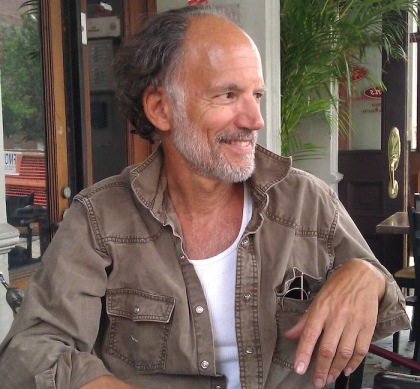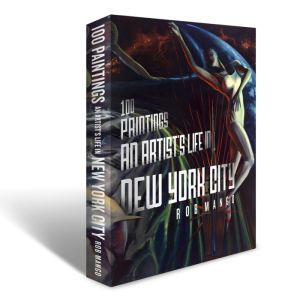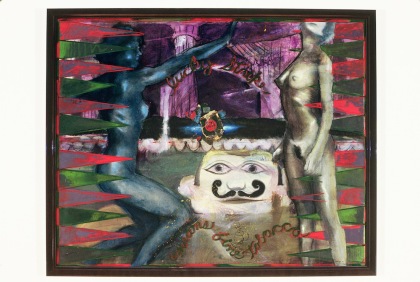Rob Mango on Tribeca Becoming Tribeca

 When I learned that artist Rob Mango—whose gallery on Duane Park is a Tribeca institution—had a new book, 100 Paintings: An Artist’s Life in New York City, I assumed it was focused on his art. But it’s so much more: a memoir about his own life, and a vivid account of the birth of Tribeca as a residential neighborhood. He agreed to let me run several excerpts, along with the corresponding paintings. The book is available at Rob’s gallery at 178 Duane as well as robmango.com, Amazon, and Barnes & Noble.
When I learned that artist Rob Mango—whose gallery on Duane Park is a Tribeca institution—had a new book, 100 Paintings: An Artist’s Life in New York City, I assumed it was focused on his art. But it’s so much more: a memoir about his own life, and a vivid account of the birth of Tribeca as a residential neighborhood. He agreed to let me run several excerpts, along with the corresponding paintings. The book is available at Rob’s gallery at 178 Duane as well as robmango.com, Amazon, and Barnes & Noble.
Also! A show of Rob’s work opened yesterday at Elga Wimmer Gallery.
Previously in this series:
••• Rob Mango on Tribeca’s Pioneer Days
Note: This excerpt refers to the period of 1979 to 1983.
Five mornings a week, 20 to 30 trucks that delivered butter, eggs and cheese for the neighboring dairy wholesaler assembled in front of my studio, returning each evening by 6 p.m. The union night crew then off-loaded the semis and on-loaded the 20-foot-long box trucks parked outside my door until 5 a.m., their engines idling all night to keep the refrigeration going—producing the most toxic air you can imagine. But the union guys and I got along okay with one another. They saw me arriving home from my runs, my numerous side jobs, art openings, or at 2 a.m. from clubs (downtown nightlife was incomparable then). We exchanged quips, stories and observations on the fraught collection of weirdos smoking crack and hanging in the park across the street. Inevitably, we all expressed dismay about the lack of women in evidence in our downtown urban wilderness.
Unfortunately, Steve Wils, the owner of one of the four dairy wholesale businesses on the block, felt differently about me than his workers did. This was clearly in evidence one day when he burst into my space uninvited and unannounced—I was sanding the floors—and informed me that he was going to get rid of me. “You might as well leave now,” he said. His attire and demeanor seemed that of the quintessential wholesale merchant. He was wearing a black hat with a wide brim, and he waved a finger in my face. I would later find Steve to be an excellent businessman, and he ultimately evolved into a great friend and patron.
The Wils family had started the dairy wholesale business in 1921, and Steve had seen the evolution of nearby Soho from light manufacturing to trendy galleries. Worried that the same thing would happen to this neighborhood, he wanted me out. I was where I should not be: If art galleries and an increased flow of cars were the coming thing, his business operations wouldn’t be allowed to continue. Our block of Duane Street, between Hudson and Greenwich, offered a natural truck bay, due to a triangle created by the small park where crack vials now littered the ground. Steve’s fears were not unfounded, but only half right. The neighborhood would primarily attract restaurants, not galleries.
••••••••••••••
By 1981, I had a Belgian girlfriend named Marie Baron with two fingers on one hand (the others lost in an accident). She was not only beautiful and gifted, but she had a garrulous and infectious personality that cast across the neighborhood. She had a loft across the street from the Odeon where she hand-stitched the most beautiful sweaters I have ever seen. Bloomingdale’s took notice and Marie soon had rooms full of seamstresses.
From Marie’s window, I watched as the Odeon Cafeteria was transformed into the Odeon Bar and Restaurant. The former owners, Madeline and Dennis Panzer, sold the cafeteria, but not before buying one of my paintings, L.S.M.F.T. The great chef, David Bouley, would eventually open a restaurant directly across Duane from Steve Wils and me. David had no problem with the enclave of trucks being manipulated nightly throughout the Duane Triangle. Bouley’s uptown and European clientele would be titillated by our street’s mix of wholesale warehouse and artist lofts, with its chic yet remote ambiance.
New York’s real-estate developers realized that the local Washington Market purveyors were in their death throes and thus abandoning the sturdy structures built by Irish and Italian laborers in the years following the Civil War. Coping with the rising cost of doing business, attrition, and the evolving complexion of Lower Manhattan, the remaining business owners of Washington Market were beginning to move their trucks and inventory to the Bronx or Secaucus, New Jersey. By 1977, the Triangle below Canal was the next virgin residential real-estate opportunity for Manhattan developers. The neighborhood buildings, many of them unoccupied, did not have certificates of occupancy and were zoned commercial. Museum-class beauties, they were 150 years old and more than a little run down. The buildings had been discovered by artists like myself, paying low rents and living without amenities, and our numbers began to grow. Building owners could at least collect rent on lofts formerly used for storage, so they happily leased them, not quite believing or anticipating the boom about to begin. But within a year or two, landlords were attempting to flip properties to the encroaching developers.
The Lower Manhattan Loft Tenants Association was founded to protect us from the inevitable eviction notices. City Hall politicos responded positively to our ad-hoc organization and advised us that to receive protection from the developers (who started attempting to evict tenants, including me), we had to officially identify and name our neighborhood. At our next LMLT meeting, a member drew on the blackboard a triangle with Canal as its northern border, Seventh Avenue its western border, and Broadway as the eastern leg. Referred to as “the triangle below Canal Street” in our discussions with the city, its abbreviation—Tri-Be-Ca—was adopted as a matter of convenience. Once a New York Times reporter, nosing around the city planning board, adopted the name for a story, it became official. In those days before the Internet, once the Times said something was so, that was it.
The tide was clearly changing in the neighborhood. VIPs from the film industry, portfolio managers from Wall Street, and assorted professionals tired of the same old Upper East Side restaurants were buying the penthouses where I labored by day and guarded by night. They could be spotted easily perusing the hot real estate and nightlife. The block was crawling with limos by 8 p.m. The “suits” were willing to pay fifty to a hundred thousand dollars for a piece of polished flooring in an old building in Tribeca. Over in the watering holes—McGovern’s and Puffy’s, Tribeca’s artist bars of choice—we huddled in disbelief. An artist who apparently had been drinking all day conjectured, “Sometime soon those lofts will fetch a million apiece.” Obviously he needed to be cut off.
Below: L.S.M.F.T. (1985). Oil and mixed media on board. 30 x 40 in. Collection of Madeline and Dennis Panzer. Click to enlarge.














This painting was a birthday present to my wife Madeline and rumor has it that Helen was the model.L.S.M.F.T. hangs in our den in Albany and may move down to the beach house this summer.When Keith McNally opened Lucky Strike in Soho,he tried to buy it from us but we declined.Hi ,Mango,all is well with us! Dennis&Madeline